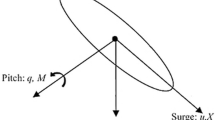Abstract
A numerical study using a computational fluid dynamics approach is conducted on the control effectiveness of a high-speed underwater vehicle with an X-stern configuration. The calculation method is verified by comparing its results with the calculation results and measurements of control derivatives of an underwater vehicle with a cruciform stern configuration. The results of the study show that the control effectiveness of a high-speed underwater vehicle is improved by about 40% in terms of control derivatives, when the cruciform stern configuration is replaced with an X-stern configuration.
Similar content being viewed by others
References
K. M. Heggstad, Why X-form rudders for submarines, Maritime Defence, January (1984) 2–6.
S. Kim et al., Flow around a control surface and torque characteristics of a rudder, Proc. of the 3 rd Naval Weapon Systems and Development Seminar, Daejeon, Republic of Korea (2000) 309–317.
D. Sen, A study on sensitivity of maneuverability performance on the hydrodynamic coefficients for submerged bodies, Journal of Ship Research, 44(3) (2000) 186–196.
C. L. Crane and A. C. Landsburg, Controllability, Chapter IX in Principle of Naval Architecture, 3 (1989).
A. J. Musker, Prediction of wave forces and moments on a near surface submarine, International Shipbuilding Progress, 31(353) (1984) 2–12.
Y. Shin, J. Lim and S. Lee, A research on the mathematical modeling for the estimation of underwater vehicle’s tail plane efficiency, Journal of the Society of Naval Architects of Korea, 42(3) (2005) 190–196.
FLUENT 6.3 User’s Guide, ANSYS Inc., Canonsburg, P.A., USA (2006).
S. V. Patankar and D. B. Spalding, A calculation procedure for heat, mass and momentum transfer in three-dimensional parabolic flows, International Journal of Heat and Mass Transfer, 15(10) (1972) 1787–1806.
T. Shih, W. W. Liou and A. Shabbir, Z et al, A new k-e eddy viscosity model for high Reynolds number turbulent flows, Computers & Fluids, 24(3) (1995) 227–238.
B. E. Launder and D. B. Spalding, The numerical computation of turbulent flows, Computer Methods in Applied Mechanics and Engineering, 3(2) (1974) 269–289.
Z. Gao, X. Li, H. Tang and Z. Gu, Three dimensional hydrodynamic model of concrete tetrahedral frame revetments, Journal of Marine Science and Application, 8(4) (2009) 338–342.
N. Mulvany, J. Y. Tu, L. Chen and B. Anderson, Assessment of two-equation turbulence modeling for high Reynolds number hydrofoil flows, International Journal for Numerical Methods in Fluids, 45(3) (2004) 275–299.
A. Tyagi and D. Sen, Calculation of transverse hydrodynamic coefficients using computational fluid dynamics approach, Ocean Engineering, 33(5–6) (2006) 798–809.
H. Schlichting, Boundary layer theory, McGraw-Hill, New York, N.Y. (1966).
GAMBIT 2.5 User’s Guide, ANSYS Inc., Canonsburg, P.A., USA (2008).
TGRID 5.0 User’s Guide, ANSYS Inc., Canonsburg, P.A., USA (2008).
S. Kim et al., A water towing tank test for submerged body, Final Report, Korea Ocean Research and Development Institute (1992).
J. Park, A study on control forces of a spade type of rudder mounted on the strut, NWSD-519-980521, Korea Agency for Defense Development (1998).
H. Kim and H. Cho, Numerical study on control derivatives of a high-speed underwater vehicle, Journal of Mechanical Science and Technology, 25(3) (2011) 759–765.
H. Cho et al., Internal report in Korean agency of defense development, 2011.
Author information
Authors and Affiliations
Corresponding author
Additional information
This paper was recommended for publication in revised form by Associate Editor Yang Na
Haedong Kim received his B.S and M.S. degrees in aerospace engineering from Seoul National University in 1989 and 1991 respectively. In 2001 he received the Ph.D in aeronautics and astronautics from Purdue University, IN, U.S.A. He is currently an assistant professor in department of aerospace engineering at Sejong University, Seoul, Korea. His main research interests are computational fluid dynamics, rotor aerodynamics, numerical methods and flow control.
Sung Kyung Hong received the B.S. degree and M.S. degree in mechanical engineering from Yonsei University, Seoul, Korea, in 1987 and 1989, respectively, and Ph.D degree from Texas A&M University, College Station, in 1998. From 1989 to 2000, he was with the Unmanned Aerial Vehicle System Div., and Flight Dynamics and Control Lab. of the Agency for Defense Development (ADD) in Korea. He is currently a Full Professor of the Department of Aerospace Engineering of Sejong University, Korea. His research interests include fuzzy logic controls, inertial sensor applications, and flight control system for Unmanned Vehicles.
Rights and permissions
About this article
Cite this article
Kim, H., Hong, S.K. Numerical study on the hydrodynamic control derivatives of a high-speed underwater vehicle with X-stern configuration. J Mech Sci Technol 25, 3075–3082 (2011). https://doi.org/10.1007/s12206-011-0927-5
Received:
Revised:
Accepted:
Published:
Issue Date:
DOI: https://doi.org/10.1007/s12206-011-0927-5




